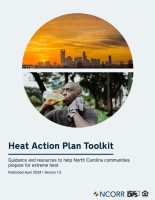
It’s not hurricanes. It’s not tornadoes. It’s not floods.
Heat is the No. 1 weather-related killer in North Carolina, but also the most preventable, according to the state’s recently released Heat Action Plan Toolkit, designed to help communities adapt as climate change drives more frequent and intense heat events.
Supporter Spotlight
“Our days and nights are getting hotter as the planet warms,” State Climatologist Dr. Kathie Dello told Coastal Review recently.
“We’re seeing more instances of record daily maximum temperatures than daily minimum records. But we’re also seeing more relentless heat — days and nights that are consistently above the temperatures that we’re used to, but maybe not Earth-shattering. And we’re seeing the hot days and nights starting earlier,” Dello said, adding that the temperature in Raleigh hit 92 degrees May 2, “Our first day over 90, about a week and a half earlier than normal.”
Children, older adults, athletes, outdoor workers and those who are pregnant, with chronic health conditions or without access to air conditioning are most vulnerable to the effects of extreme heat, but everyone is at risk.
North Carolina Office of Recovery and Resiliency Resilience Policy Analyst Andrea Webster said that deaths and heat-related illnesses from extreme heat are 100% preventable.
“While residents are used to hot temperatures, North Carolina’s coast has a high number of outside visitors in the summer months. If they come from a much cooler area, their bodies are likely less adapted to extreme heat. Messaging about symptoms, cooling and hydration strategies, and resources to stay cool can drastically reduce health impacts and emergency department visits,” Webster said.
Supporter Spotlight
This is where the toolkit comes in.
The 72-page document features a template with fill-in-the-blank language for local governments, health departments and other entities to write its own heat action plan, as well as about the causes and symptoms of heat-related illnesses, groups most at risk, and where to look for funding. Supplemental materials for getting the word out to the public such as sample graphics, factsheets, brochures, and scripts to warn of impending high heat are on the toolkit website.
“With the frequency and severity of extreme weather increasing, it’s more important than ever to build local resilience that will help protect people and save lives,” Gov. Roy Cooper said when the plan was announced in late April. “The new toolkit provides valuable resources that will help local governments prepare for and respond to these potentially life-threatening events. The project also underscores how state partnerships are critical to finding climate solutions that benefit all North Carolinians.”
About the toolkit
The Office of Recovery Resiliency led the effort in partnership with Dello’s State Climate Office of North Carolina, the N.C. Division of Public Health, Duke University Heat Policy Innovation Hub and the National Oceanic and Atmospheric Administration Carolina’s Climate Adaptation Partnership.
The idea for the toolkit came about as part of the Regions Innovating for Strong Economies & Environment, or RISE, program, according to the website. Participants from across the state said a heat action plan template was a priority resilience project.
Dr. Rebecca Ward, a postdoctoral research scholar, was lead developer of the toolkit and collaborated heavily with Webster. Ward is with North Carolina State University’s Coastal Resilience and Sustainability Initiative and the NOAA Carolina’s CAP.
Ward explained that developing the Heat Action Plan Toolkit took about a year, from initial idea to final product.
“Throughout the whole process, I’ve been continually delighted with how many different groups and individuals have shared their time and expertise to help create content and give feedback. We’ve done our best to make sure that this will be useful and usable — very ‘plug-n-play’ — for its target audiences of local governments, primarily health departments and emergency management,” Ward said.
Webster said that local and county governments, health departments and other leaders can use the toolkit to ensure there is a plan in place for when a heat wave is in the forecast, and to ensure that community partners are developing and pursuing resources that help residents and visitors cool down when it’s hot.
“We know that local government leaders are juggling so much — and the more invisible hazards, like heat, may not be top of mind for folks. We’re also just dealing with summers like we haven’t seen in our past,” Dello said. “What used to be a once in a generation hot summer is now happening more frequently. We designed it so it would be helpful and accessible for everyone.”
Webster said the meat of the toolkit is the template heat action plan.
“This word document is already designed with draft text. We want to encourage jurisdictions and community partners to work together to pick out the suggested heat resilience actions that work best for their community and start implementing the actions in the plan,” Webster said.
A list of resources is included for community leaders to contact for help filling in the template ahead of an extreme heat event, and provides instructions on how to identify census tracts with high concentrations of residents especially vulnerable to extreme heat, such as the elderly, she said.
Leaders can access region-specific heat thresholds to know when to send out heat awareness messaging, which is part of the toolkit. There is sample messaging, graphics, fact sheets, checklists, sample community surveys to understand how residents currently deal with extreme heat. Many of the toolkit’s supplemental materials are also available in Spanish.
“NCORR plans to offer workshops for communities to begin developing their heat action plans. Sign up for our e-newsletter to learn about upcoming offerings,” Webster said.
Ward said that the workshops are to take place over the next few months with target users to work through the toolkit.
“I think these will be great opportunities to advance our state’s resilience to extreme heat, and any feedback collected during these workshops will ultimately improve the Toolkit, making it more useful and usable — and we hope used — by local governments across the state,” Ward added.
Webster said that so far, the public health preparedness coordinators are particularly excited about the toolkit, and Chatham County used a draft of the Heat Action Plan Toolkit to publish the first Heat Action Plan in the state.
“Heat affects our residents’ health, and it’s often overlooked as a health concern. Having easy-to-use resources at their fingertips is helpful,” Webster said.
Heat illnesses in numbers
The state Department of Health and Human Services has been recording reported heat-related illnesses for some time.
Every year during the heat season May 1 to Sept. 30, the department’s climate and health program publishes heat-related illness surveillance reports. The first report of the year is expected to be on the website by Wednesday, May 15.
In past years, the reports provided statewide data on heat-related illness. This year, weekly reports will also include regional summaries and some county-level information, the department said.
Last year, North Carolina had more than 3,900 emergency department visits for heat-related illness between May 1-Sept. 30, with 497 of those in North Carolina’s 20 coastal counties.
The department’s numbers show that between 2016 and 2023, these counties had around 4,300 total reported heat-related illness emergency department visits.
Department officials noted that the annual number of visits are based on the patient’s county of residence, not where they sought medical attention.
For example, a Wake County resident who seeks help at an emergency department for heat-related illness in Carteret County may not be included in Carteret’s count.
“Heat-related illness can affect anyone. People who are accustomed to this weather should still watch for the signs and symptoms of heat-related illness and take precautions to protect their health,” a health department spokesperson said. “Take the heat seriously and do not ignore danger signs like nausea, headache, dizziness or lightheadedness, confusion, and rapid or erratic pulse. They can all be signs of trouble. Get to a cool place, drink water slowly and seek medical help if conditions don’t improve.”
The long-term heat forecast
Webster said her office relies on predictions in the 2020 North Carolina Climate Science Report, which states that, for the coastal plain, “climate models project a substantial increase in the number of these very hot days and very warm nights by mid- to late century under both scenarios.”
By 2100, the number of very hot days is projected to increase by 11 to 49 under the lower scenario and 42 to 94 under the higher scenario, compared to the 1996–2015 average. The number of very warm nights is projected to increase by 14 to 45 under the lower scenario and 48 to 87 under the higher scenario, she sited from the report, adding that the State Climate Office regularly updates their projections, so it’s possible that they may have newer data that aren’t published as a report yet.
“We need to start preparing for more frequent heat waves and high nighttime temperatures. That continued stress on our bodies leads to health impacts such as heat cramps, heat exhaustion, heat stroke and even mortality,” Webster said.
Resources
Webster said that residents can sign up to receive heat alerts when the weather is forecast to reach unhealthy temperatures.
The emails from the state health department’s Heat Health Alert System notify when the heat index is forecast to reach unhealthy levels in their county. The sign-up form is available in English and Spanish.
Other resources include the federally funded Crisis Intervention Program administered by the state Department of Social Services that assists those experiencing crises related to temperature, and Operation Fan Heat Relief for eligible adults to receive fans through their local Area Agency on Aging.
Warning signs and symptoms can be found on the Center for Disease Control and Prevention’s webpage on extreme heat symptoms as well as tips for preventing heat-related illness.
Webster said that visitors and everyone spending time outdoors or in unairconditioned spaces throughout the summer months should pay attention to how they feel in high temperatures.
“Stay hydrated, take breaks in the shade, and cool off in cold water. Watch out for dizziness, nausea, heavy sweating, heat cramps and painful muscle cramps in the abdomen, arms or legs following strenuous activity,” Webster said.
The health department recommends taking the following steps during heat season:
- Increase fluid intake.
- Wear sunscreen of 15 SPF or higher. Sunburn affects your body’s ability to cool down.
- Spend some time in a cool or air-conditioned environment.
- Reduce normal activity levels.
- Cool off by taking cool baths or showers, or placing ice bags or wet towels on the body.
- Stay out of direct sunlight, put shades over the windows, and use cross-ventilation and fans to cool rooms if air conditioning is not available.
- Wear lightweight, light-colored, loose-fitting clothing that permits sweat to evaporate.
- Drink plenty of liquids such as water and sports drinks to replace the fluids lost by sweating. As a person ages, thirst declines.
- Limit intake of alcoholic beverages or sugary drinks. If you are on a low-salt diet or have diabetes, high blood pressure, or other chronic conditions, talk to your doctor before drinking sports drinks.
- Check up on friends or neighbors who live alone.
- Never leave children or pets unattended in vehicles, even for a few minutes, as temperatures inside a car can reach a deadly level quickly.
- This can also be a good time to join your local senior center or take advantage of buildings made accessible to seniors during excessive heat. Your community’s public information office can be contacted for additional information.
- Residents are encouraged to speak with their healthcare provider about how to stay safe. Certain medications make you more vulnerable to heat-related illness.
- Keep your medicines in a cool, dry place.









